MORS PORTA VITAE - DEATH THE GATE OF LIFE: Old Zagreb cemeteries and funerals
Exhibition concept: Slavko Šterk, Boris Mašić
Visual and spatial design: Lana Kovačić, Željko Kovačić
Poster design: Lana Kovačić
Sound backdrop: music selected by Maja Šojat-Bikić, Vito Gospodnetić, Vilena Vrbanić, Ivan Živanović; authentic recordings of Zagreb funerals; Vito Gospodnetić; sound engineering and mastering: Vito Gospodnetić
.jpg)
The exhibition entitled MORS PORTA VITAE – DEATH THE GATE OF LIFE: Old Zagreb cemeteries and funerals takes as its theme death, the way of thinking about death, funerals and cemeteries during the Zagreb past. At first conceived as project providing a context for the presentation of sites at which the inhabitants of Zagreb were interred, it grew into an exhibition in which material testimonies related to death and the burial rite are shown. For this reason the exhibition has been divided into two parts.
The first part of the exhibition is structured into eight topics, and shows objects that, after a unit concerning the genesis of the model of contemporary cemeteries and Christian eschatology, exemplify actions related to death from a wider aspect: the writing of wills and receiving the sacrament of extreme unction, via the moment of death itself and accompanying actions – such as the publication of death notices or preparations of the bier – to the organisation of funerals, the actual interment and recollections of the deceased. On show, then, are: the will of Juraj Vernić of 1636; a vessel used during extreme unction that the parish priest of Remete, Matija Pavlec, had made in 1863; the farewell letter for Terezija pl. Ivančić of 1835; the facsimiles of Pamjatkin (Memorial book) of the Church of the Transfiguration in Zagreb and of the drawing for the Castrum doloris of the commander of the Military Frontier, Count Ivan Herbert Ausperger, placed in 1669 in the Church of St Catherine in Zagreb; the oldest extant specimens of death notices and so on.

“Cap of fortunate death” from the legacy of Baroness Kornelija Balby that E. Laszovski entered in the inventory in 1926 with the remark: usual in Zagreb. “Cap” is one of the expressions of Christian piety in which prayers are addressed to St Joseph for a fortunate death. MGZ 4510

Death notice of August Šenoa, Zagreb, December 15, 1881, printed by C. Albrecht in Zagreb, MGZ 54715

The Pamyatkin (Memorial book) of the Church of the Transfiguration
in Zagreb, Zagreb, October 1, 1828, property of the Museum of the
Serbian Orthodox Eparchy of Zagreb and Ljubljana

The Castrum doloris of the Commander of the Military Frontier, Count Ivan Herbert Ausperger, in the Church of St Catherine in Zagreb, 1669, Johann Caspar Mannaser (1640-1684), facsimile, original in the Metropolitana Library
Included in the themes of the first part of the exhibition come original objects ranging from documents and books of the early modern period (the rituals of Senj and of Rome...) and the oldest extant death registers in the parishes of Zagreb from the 18th century, as well as photographs of contemporary European and Croatian cemeteries, even a bust for a funerary monument of Jim Morrison. Then there are photographs, copies from the press, drawings, obituaries, letters of condolence and epitaphs as well as films of the funerals of Pavle Radić and Dr Đuro Basariček, who were killed in Belgrade on June 20, 1928. An endeavour has been made, by presenting the funerals of some well-known Zagreb people (Gjuro Szabo, Vladimir Horvat and others), the exhumations of famed personalities of Croatian and Zagreb history (the July Martyrs of July 13, 1895), pictures of funerals in Zagreb and the immediate vicinity (Ščitarjevo), a depiction of undertakers and the organisation and decorators of graves at the turn of the 19th and 20th centuries to provide a framework for a culturological image of Zagreb and its inhabitants in the encounter with death and the pain of bereavement. In this part, a kind of exhibition tunnel through time has been created, unconcerned with precise chronology, in which the exhibits tell of the concept of death, the place of the interments and the funeral customs.
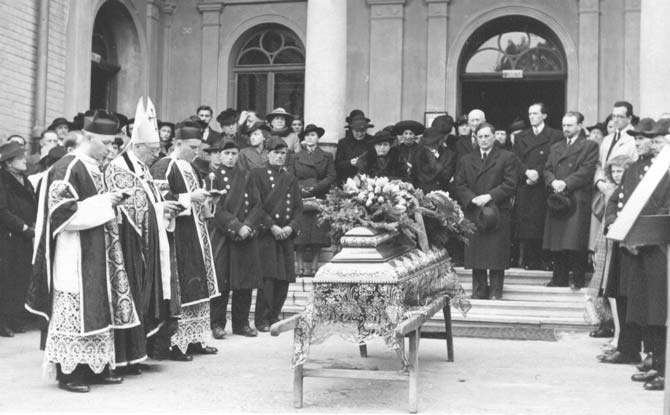
The funeral of Gjuro Szabo at Mirogoj, conducted by Franjo Šeper, rector of the Zagreb Archiepiscopal Seminary, May 3, 1943; photo: Tihomil Stahuljak

Front cover of the photographic album To the Martyrs April 30, 1919, Zrinski and Frankopan memorial on the occasion of the solemn transfer of their mortal remains to the homeland, MGZ 54253
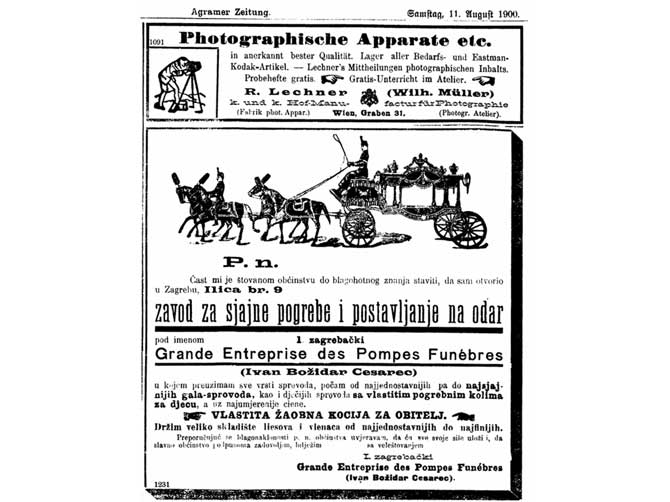
Copy of a newspaper advert of the Ivan Božidar Cesarec 1st Zagreb
Institute for Fine Funerals, Ilica 9, Agramer Zeitung, August 11, 1900
By contrast, the objects and topic of the second part of the exhibition are clearly delimited in time and space. Just as in the first part of the exhibition the phenomenon of death is pondered with a sensitivity bordering on the intimate, so in the second part the depiction of old Zagreb graveyards is treated with formal restraint. It presents the graveyards within the space occupied by the city at the moment when, by the Imperial Patent of Franz Joseph I (1850), Zagreb said farewell to the medieval framework of law and governance and became a contemporary central European city, which, today, is practically coexistent with the zone covered by the legally protected historical urban unit – the city of Zagreb. The cemeteries in Vrapče and alongside the church of the Blessed Virgin Mary in Remete are at an intentional remove from that area, made so as to complete the image of the culture. Deliberately, then, from this depiction the central municipal cemetery of Mirogoj has been omitted. This was done because the date of its opening, 1876, well nigh coincides with the time of the Imperial Patent, and partially because it and the Crematorium, provided a fairly adequate solution for the problem of burials in Zagreb, but mainly because it is one of the most important heritage structures in the city and thus constitutes a highly demanding project, perhaps even an exhibition to itself.
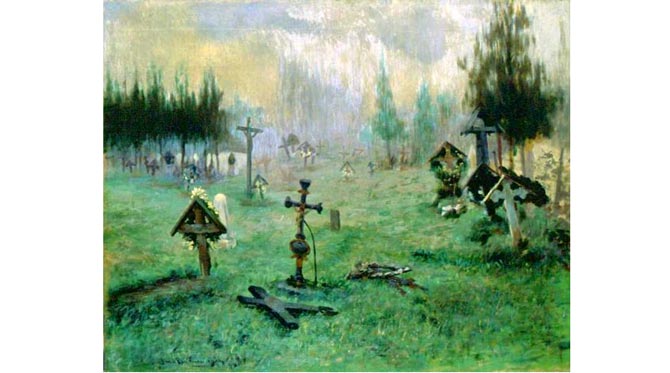
The old soldiers' graveyard, Joso Bužan, Zagreb, 1904. god., MGZ 197
This part of the exhibition starts with the earliest, prehistoric, Antique and early medieval cemeteries and graves. This includes a few graves discovered by accident during building works or in archaeological excavations. The finds of these graves give a picture of the eschatological beliefs of the inhabitants of what is today Zagreb, and also show the Antique road communications and the social conditions of the time in which they were created. The remaining cemeteries are shown in the form of a walk through the current city. As far as this was feasible, the chronological sequence of the foundation of the parishes on Kaptol and Gradec was respected, and the occasional divergence from this principle was done for the sake of easier visitor perception of the spatial disposition of the cemeteries in these settlements. Within these topics, the histories of the parishes in the area and of the churches around which the former citizens of Zagreb were buried are given summary treatment. The sites of graves and graveyards are presented with photographic archive material, objects found during archaeological research, funerary monuments, maps and drawings of Zagreb with the graveyards marked in, and so on. The number of exhibits in a given topic is proportional to the number of testimonies to the contents preserved, and it is sometimes visualised only via recent material.
In the Kaptol part of the cemeteries the oldest medieval archaeological finds are presented, telling of the existence of a graveyard around the Church of St Emeric on the Kaptol, funeral slabs and the disposition of graves in the cathedral, photographs of tombs and pilgrims’ medals related to the Church of St Mary at Dolac, archaeological finds from Opatovina unearthed during investigations of the cemetery alongside the Church of St Francis, the Christian and Jewish cemetery in Petrova ulica, the recently investigated cemetery alongside the Church of the BVM and the Carmelite Monastery in Remete and so on.
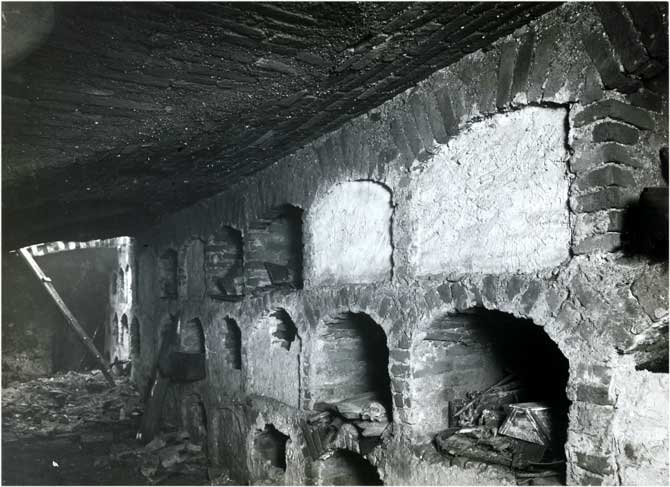
Subterranean vaults related to the Church of St Mary at Dolac, photo: Rudolf Firšt, 1928, MGZ fot. 1660
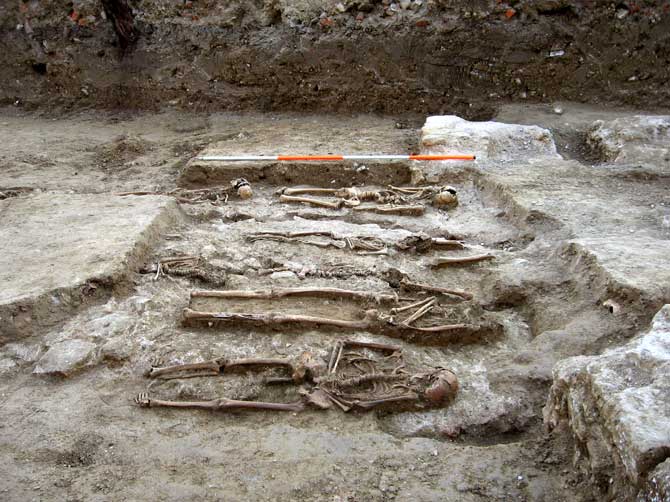
Graves found during archaeological excavations in the Church of the Blessed Virgin Mary in Remete, photo: Tajana Pleše, 2008

Graves found in Grič Park, photo: Buga Pantlik, 2007 Gravestone of the first rabbi of Zagreb,
Aaron Palota, buried at the one-time
cemetery in Roko’s Park, 1849,
property of the Jewish Commune of Zagreb
The upper town graveyards start with archaeological excavations alongside St Mark’s and the irrefutable proofs that the cemetery in this place predated the Mongol invasion and the construction of the church in the mid-13th century, as well as of the continuation of the interment of the dead in this place even at the end of the 15th century, when historical sources record that shops were built alongside the church. Archaeological finds are also part of the thematic unit concerning the graveyard in today’s Grič Park and the tombs from St Mary’s Chapel on Grič. Then come a number of sites at which bodies from the Upper Town were buried, from St Catherine’s via the Chapel of St Ursula all the way to the Jurjevska cemetery and the cemetery at what is today Roko’s Park, from which, among other things, the funerary monument of the first rabbi of Zagreb is exhibited. Grave sites outside the consecrated cemetery, such as family tombs and the like, are treated in the segment of the exhibition within which, through an archaeological find, a case of infanticide and an example of the interment of a suicide, are documented, the latter recorded in a special remark in the register of deaths of the Parish of St Mark.
The final unit speaks about the decline of spirituality and piety about the dead in contemporary society, giving as an example of this conclusion the degradation of the hospital cemetery in Vrapče and the new concepts of eschatological symbolism through everyday use items.
The experience of the exhibition has been enhanced through a 55-minute sound backdrop with selected works of Croatian sacred music from the 17th to the 20th century and with authentic sound recordings of Zagreb funerals from the 1970s.
The mounting of this exhibition required not only an outstandingly professional approach, but also considerable creative and inspirational engagement from the designers.
More than 900 exhibits and museum aids collected from numerous heritage and similar institutions and religious communities and personal memorabilia indite a social and historical overview of the concept of death and the life beyond the grave of the former inhabitants of Zagreb, opening up a series of topics for future researchers into the history of the city. On the other hand, reference is made to burial and funeral customs in various phases of Zagreb history, either as cultural particularity of the Middle Ages, in which the deceased were interred in the squares around the churches, where fairs and markets were also held, or that cemeteries once existed at places that are today put to an entirely different purpose, the memory of them having been lost.
Boris Mašić
Pictures from the exhibition

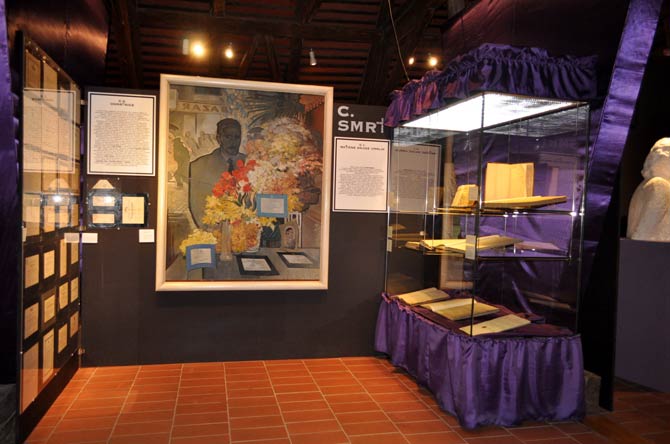

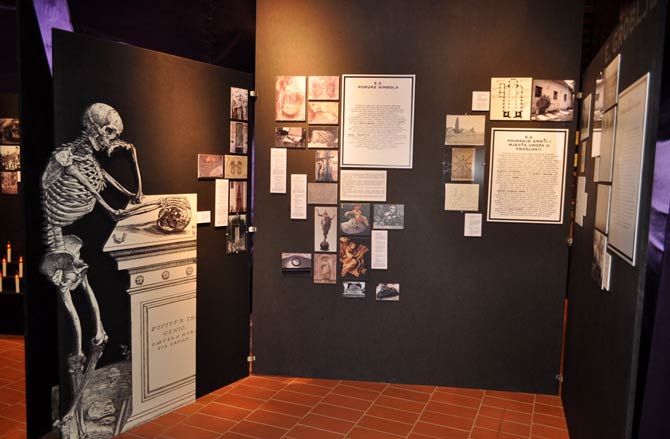

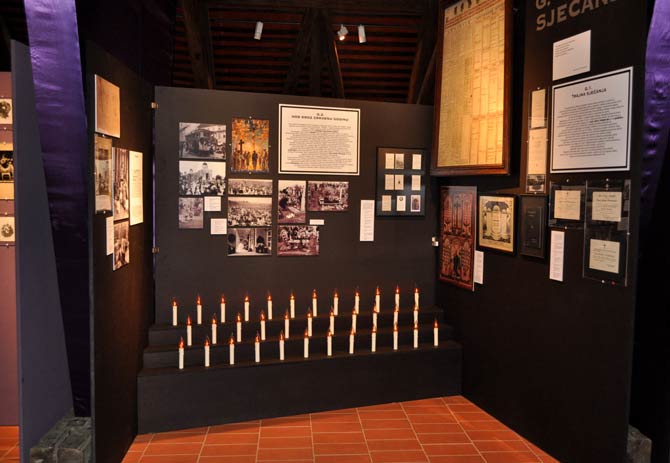

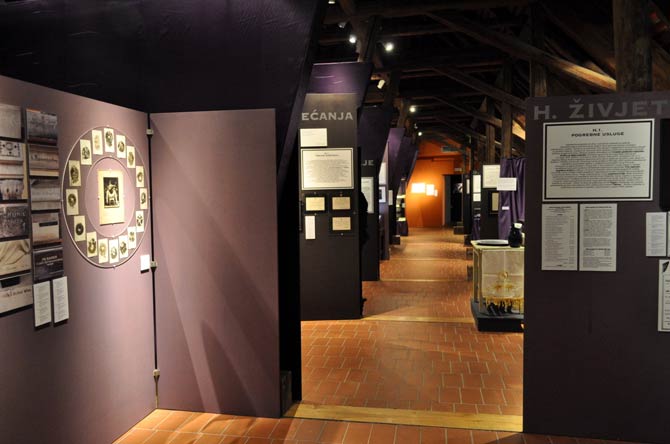

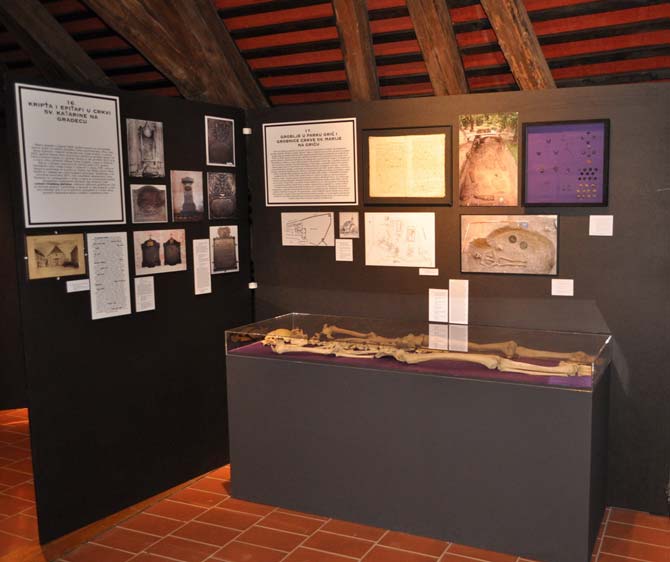


photo Miljenko Gregl, ZCM
Related publications
 Šterk, Slavko; Boris Mašić. MORS PORTA VITAE - DEATH THE GATE OF LIFE: Old Zagreb cemeteries and funerals.
Šterk, Slavko; Boris Mašić. MORS PORTA VITAE - DEATH THE GATE OF LIFE: Old Zagreb cemeteries and funerals.
Zagreb : Zagreb City Museum, 2011
[brochure]
 Exhibition catalogue
Exhibition catalogue
Šterk, Slavko, Boris Mašić. Mors porta vitae – Death the gate of life : old Zagreb cemeteries and funerals.
Zagreb : Zagreb City Museum, 2014

